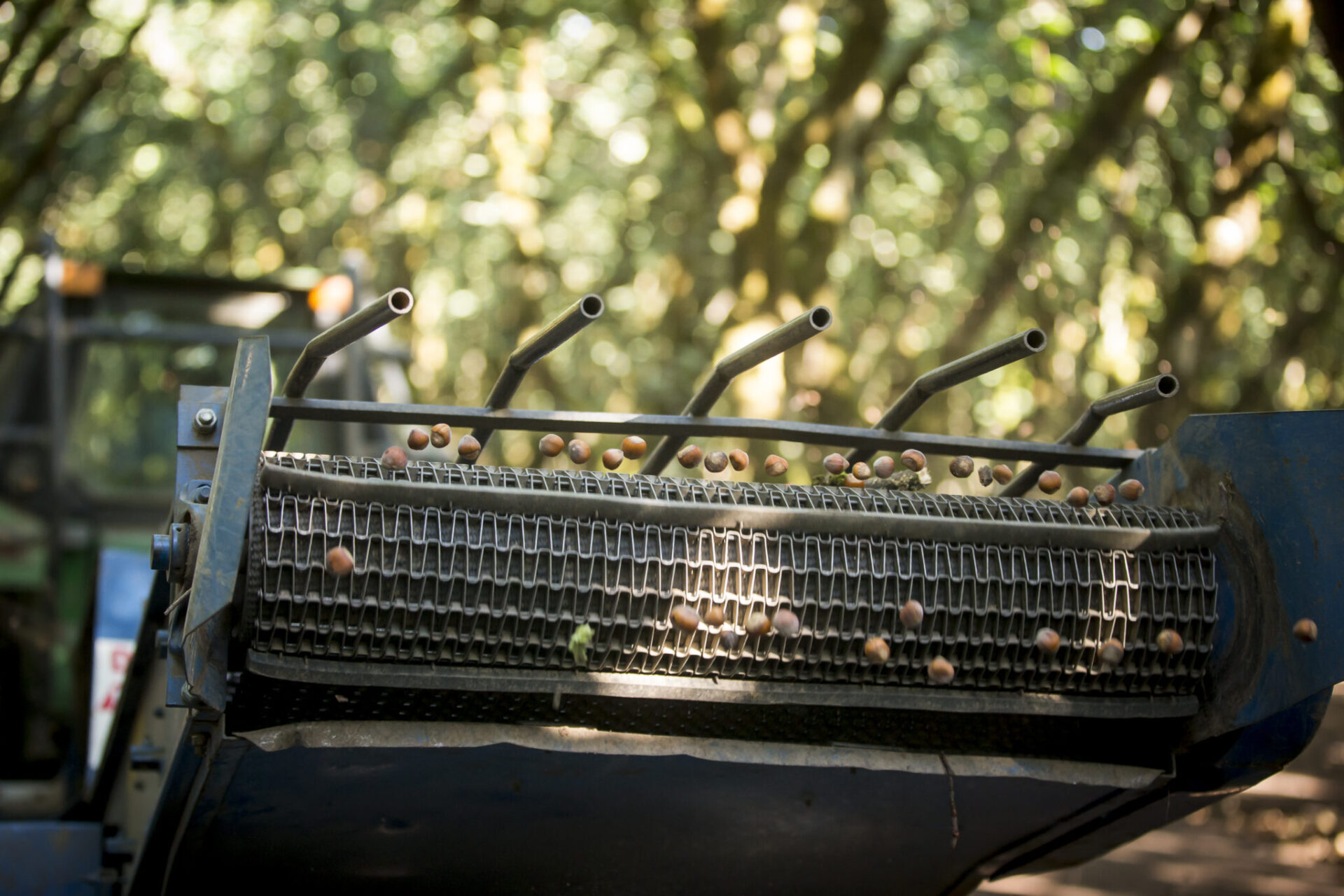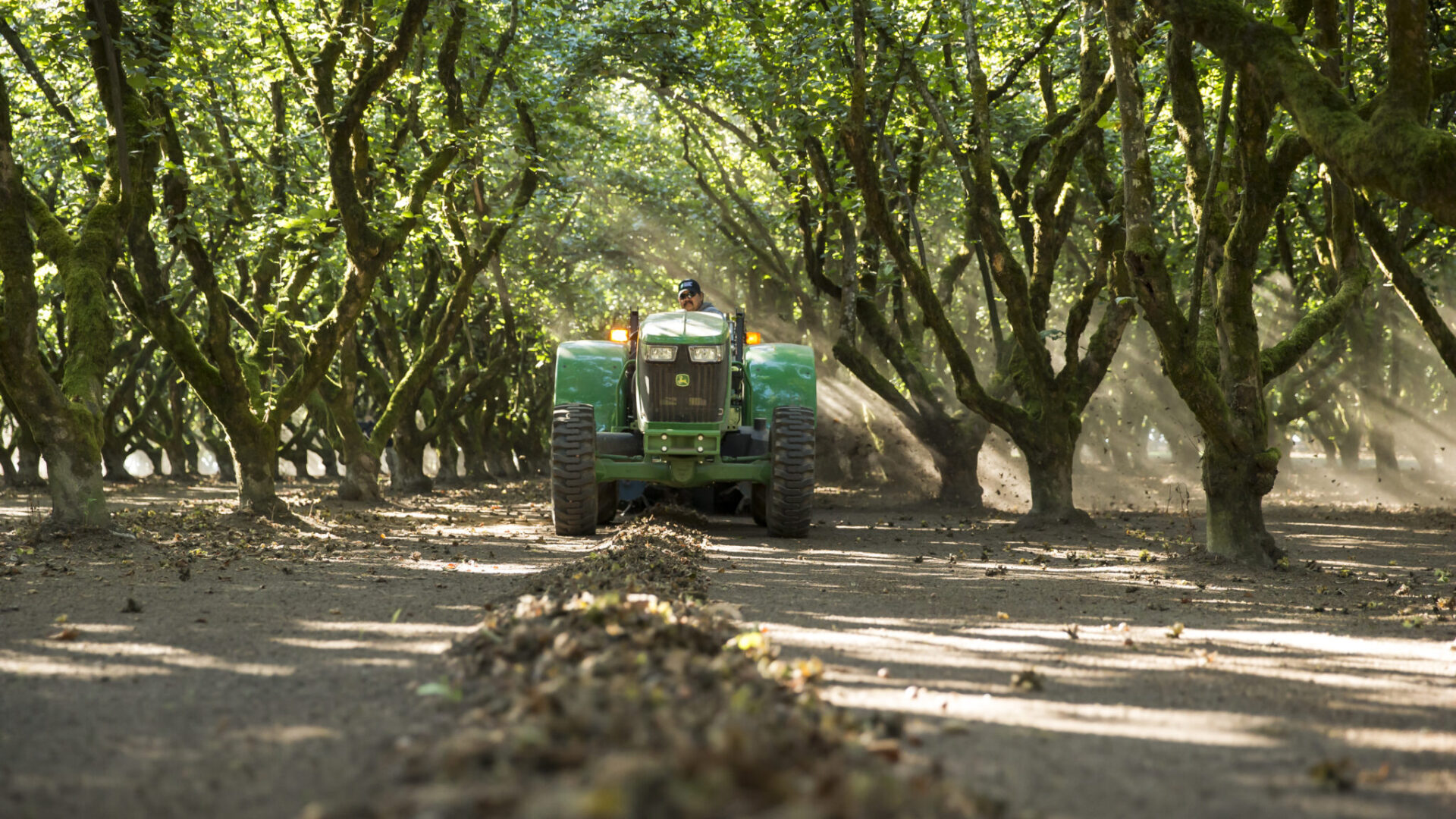
Hazelnut harvest is here. This month, hundreds of farmers throughout the Willamette Valley will take to the orchard to harvest millions of pounds of Oregon’s state nuts. This year could mark a new yield standard for the U.S. hazelnut industry, but to achieve this herculean task, proper harvest preparation and maintenance must come first.
These nine steps will help keep harvest going smoothly; some of them may sound basic but are still often neglected and can lead to downtime in the field or a trip to the shop.
Dirt is the enemy
Dirt, in all its forms, is the nemesis of a successful harvest and operational harvest equipment. In dry conditions, dirt can be easily blown around and get caught up in the blower fan during harvest. In wet conditions, mud sticking to the nuts will build up in the machinery. A final, thorough pass of the flail and scraper will go a long way toward a smoother harvest.
If adverse conditions arise, it will pay dividends in the long run to take frequent breaks to clear out any type of dirt build up.
Begin with Bearings
Bearings are the lifeline for any piece of farm equipment. They will give insights into the health of the machine. It is nearly impossible to over lubricate bearings, so begin harvest with freshly serviced bearings and gear boxes.
In addition, checking bearing temperature with a probe will also prevent issues in the long run; high temperatures in a bearing indicate failure is imminent. These bearings should be replaced before harvest begins.
Take Everything for a Test Drive
Just like getting behind the wheel of a new car before purchasing, every piece of harvesting equipment should be given a test drive before heading out into the field. No matter how old an implement is, this should be repeated before every harvest. First, pull each item onto a safe surface outside of the orchard and simply fire up the engines; let it run for a while and listen and observe the machinery. An extended dry run will help identify potential problem areas and better allow for preventive maintenance, rather than lose time in the field during a breakdown.
Pay special attentions to leaks and any potentially loose belts. There is no such thing as too much time doing a dry run, greasing key points and tightening every part of any implement.
Small Rodents, Big Problems
Equipment that is left largely unused, if not untouched, for 10 months out of the year can become a haven for rodents. There are plenty of places to hide, and equipment that has spent many hours in a hazelnut orchard is a lush food source. Even the smallest residual shells, leaves or kernels can entice rodents into the shed.
Additionally, these animals can gnaw through nearly any non-metallic surface on a sweeper or harvester. Thus, a thorough inspection of all hoses and wiring is crucial. Not only can damage inhibit equipment performance, but rodent nests and damage can also be a fire hazard.
Sweeper Check
Sweepers should be the first piece of equipment thoroughly inspected; a delayed sweeper means a delayed harvest all around. In addition to the aforementioned bearing checks and thorough tightening, focus on basic cleaning. Extra scrutiny needs to be given to the brushes/bristles and tine bars to ensure these are in full working order. If wear is evident, replace before going into the fields.
Lastly, double-check the mounting hardware for proper tightness and review the hydraulic system. A good rule of thumb is for 500 hours for hydraulic oil in a sweeper. Once beyond that threshold, service the hydraulic system.
Harvester/Picker Maintenance
The implement most likely to give a grower headaches during harvest time is the harvester. With so many intricate pieces that need to work in unison, even the slightest equipment failure could severely delay harvest. U-joints are a frequent problem area, yet issues are easily avoidable if properly inspected before harvest. The paddle wheels can wear very quickly and should be changed if damage is visible. A similar situation can arise with suction fan blades and should be identified during the test run.
The conveyor belt on the harvester produces its own set of unique challenges. A malfunctioning conveyor chain is near the top of the list of worst breakdowns. During the test run, give the chain plenty of time to run and build up temperature. Keep an eye on the hydraulic system and drive sprockets, as these two must be in working order before harvest.
Lastly, calibrate the height of the harvester. It may sound elementary, but a harvester set too high versus one set too low could mean the difference between picking up mounds of dirt with the hazelnuts and missing nuts altogether. It is possible to get a good feeling for the proper height by doing the test run on a smooth, flat surface and observing how close to the ground the paddles are. One of the more ingenious ways to improve harvester height is by simply inflating or deflating the tires to the desired level.
Blower Maintenance
Blowers can also prove to be particularly problematic if not exquisitely maintained. Fan blades take a lot of damage throughout years and years of harvest and should be replaced regularly. Another easy yet oft overlooked area is the air intake system and air filter; thoroughly clean the air intake and replace the air filter before each harvest.
Don’t Out-Sweep the Harvester
It may sound simple, but it’s imperative to strike a balance between the rate of the sweeper windrowing the nuts and the harvester collecting. While spread out on the orchard floor, hazelnuts can last a long time before deteriorating. However, once they are compiled into tight windrows, the airflow is diminished, and the kernel quality can begin to diminish. If a heavy storm comes, those residual nuts can turn into a near total loss.
Prepare Your People
Hazelnut harvest is a team effort, and the importance of properly preparing the workforce for harvest can’t be overstated. This includes lining up paperwork, insurance and licenses as well as providing safety education. Lastly, don’t forget to line up details with the receiving stations and handlers! This includes ordering tote boxes and transportation logistics.
Harvest is the most pivotal time of the year. There is no such thing as being too thorough. As the old adage goes, “prior proper preparation prevents poor performance.”











